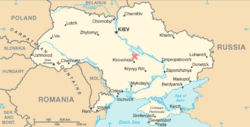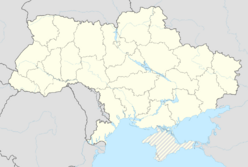Earth:Boltysh crater
| Impact crater/structure | |
|---|---|
| Confidence | Confirmed[1] |
| Diameter | 24 kilometres (15 mi) |
| Depth | 550 metres (1,800 ft) |
| Location | |
| Coordinates | [ ⚑ ] : 48°54′N 32°15′E / 48.9°N 32.25°E |
| Country | Ukraine |
| Region | Kirovohrad Oblast |

The Boltysh crater or Bovtyshka crater is an impact crater in the Kirovohrad Oblast of Ukraine ,[1] near the village of Bovtyshka. The crater is 24 kilometres (15 mi) in diameter and its age of 65.17 ± 0.64 million years, based on argon dating techniques, is within error of that of Chicxulub crater in Mexico and of the Cretaceous–Paleogene boundary (K–Pg boundary). The Chicxulub impact is believed to have caused the mass extinction at the end of the Cretaceous period, which included the extinction of the non-avian dinosaurs. The Boltysh impact likely occurred several thousand years after Chicxulub, suggesting the extinction event may have been driven by multiple meteor strikes over an extended period of time about 65 million years ago.[2]
Overview
Boltysh crater is located in central Ukraine, in the basin of the Tiasmyn River, a tributary of the Dnieper River. It is 24 kilometres (15 mi) in diameter, and is surrounded by an ejecta blanket of breccia preserved over an area of 6,500 square kilometres (2,500 sq mi). It is estimated that immediately after the impact, ejecta covered an area of 25,000 square kilometres (9,700 sq mi) to a depth of 1 metre (3.3 ft) or greater, and was some 600 metres (2,000 ft) deep at the crater rim.
The crater contains a central uplift about 6 kilometres (3.7 mi) in diameter, rising about 550 metres (1,800 ft) above the base level of the crater. This uplift currently lies beneath about 500 metres (1,600 ft) of sediment deposited since the impact, and was discovered in the 1960s during oil shale deposits exploration.
Age
When first identified, the age of the crater could only be roughly constrained between the age of the impacted rocks (the target) and the age of overlying sediments. The target rocks date from the Cenomanian (98.9 to 93.5 million years ago) and Turonian (93.5 to 89 million years ago) epochs. Bore samples of sediments overlying the crater contain fossils dating from the Paleocene epoch, 66 to 54.8 million years ago. The age of the crater was thus constrained to between 54 and 98 million years.
Subsequent radiometric dating reduced the uncertainty. The concentration of U238 decay products in impact glasses from the crater were used to derive an age of 65.04 ± 1.10 million years. Analysis of argon radioactive decay products yielded an age of 65.17 ± 0.64 million years. These ages are similar to that of Chicxulub Crater which argon dating yielded an age of 66.043 ± 0.011 million years.
Radiometric dating places the Boltysh crater thousands of years after the Chicxulub crater, but an August 2010 study of ancient fern spikes suggests the Boltysh impact may have occurred several thousand years before Chicxulub.[2]
Likelihood of multiple impact

The ages derived for Chicxulub and Boltysh are close given their statistical errors, but it does not necessarily follow that they formed at exactly the same time. At the estimated rate of impact events on Earth, it would not be extremely unusual[citation needed] for a Boltysh-sized crater to be formed within half-a-million years of Chicxulub. The dating of these impact craters is not yet accurate enough to establish whether the impactors arrived thousands of years apart, perhaps as part of a generally elevated rate of impacts at that time, or were almost simultaneous, like the impacts of the fragments of Comet Shoemaker-Levy 9 on Jupiter in 1994.
The discovery of the unconfirmed Silverpit crater and the early report of its age as 65–60 million years[3] initially gave greater weight to the hypothesis that the Earth was struck by multiple impactors at this time, however, the age estimate has now been broadened to 74–45 million years.[4]
A probable impact crater[5] called Shiva crater is claimed to have formed around the same time, but its status as an impact crater is disputed.
References
- ↑ 1.0 1.1 Boltysh at EID
- ↑ 2.0 2.1 "Double meteorite strike 'caused dinosaur extinction". BBC News. 2010-08-27. https://www.bbc.co.uk/news/science-environment-11112417.
- ↑ Stewart SA; Allen PJ (2002). "A 20 km-diameter multi-ringed impact structure in the North Sea". Nature 418 (6897): 520–3. doi:10.1038/nature00914. PMID 12152076. Bibcode: 2002Natur.418..520S.
- ↑ Stewart, S. A.; Allen, P. J. (2005). "3D seismic reflection mapping of the Silverpit multi-ringed crater, North Sea". Geological Society of America Bulletin 117 (3): 354–368. doi:10.1130/B25591.1. Bibcode: 2005GSAB..117..354S. http://bulletin.geoscienceworld.org/cgi/content/abstract/117/3-4/354.
- ↑ Shiva
Further reading
- Grieve, R. A. F., Reny, G., Gurov, E. P., & Ryabenko, V. A. (1987). The melt rocks of the Boltysh impact crater, Ukraine, USSR. Contributions to Mineralogy and Petrology, 96(1), 56–62.
- Grieve R.A.F., Reny G., Gurov, E.P., Ryabenko V. A. (1985), Impact Melt Rocks of the Boltysh Crater, Meteoritics, v. 20, p. 655
- Gurov, E. P., Kelley, S. P., Koeberl, C., & Dykan, N. I. (2006). Sediments and impact rocks filling the Boltysh impact crater. In Biological processes associated with impact events (pp. 335–358). Springer Berlin Heidelberg.
- Gurov E.P., Gurova H.P. (1985), Boltysh Astrobleme: Impact Crater Pattern with a Central Uplift, Lunar & Planetary Science XVI, pp. 310–311
- Jolley D., Gilmour I., Gurov E., Kelley S., Watson J. (2010) Two large meteorite impacts at the Cretaceous-Paleogene boundary Geology September 2010, v. 38, pp. 835–838, doi:10.1130/G31034.1
- Kashkarov L.L., Nazarov M.A., Lorents K.A., Kalinina G.V., Kononkova N.N. (1999), The Track Age of the Boltysh Impact Structure, Astronomicheskii Vestnik, v. 33, p. 253
- Kelley S.P., Gurov E. (2002), The Boltysh, another end-Cretaceous impact, Meteoritics & Planetary Science, v. 37, pp. 1031–1043



